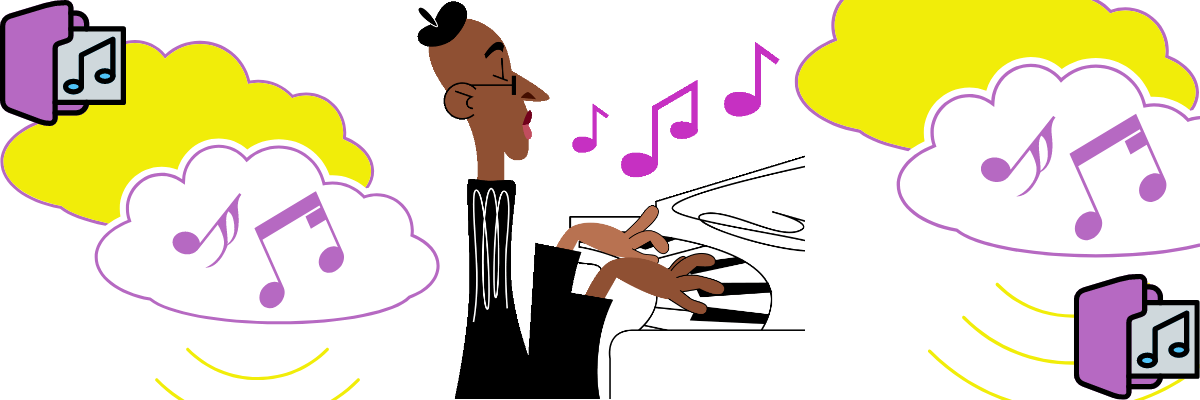Like the Metadata Co-op at PBS, Universal Music Studios and the Digital Data Exchange (DDEX) are on a mission to get producers involved early in the creation of metadata for their work—which is why Universal and DDEX created a six-minute video featuring jazz legend Herbie Hancock just for producers and others involved in content creation, titled Metadata—You Know You Want It!
In the video, Hancock and a half-dozen Grammy award-winning sound engineers and other music professionals talk metadata—about how boring and complicated it sounds, and how important it is. In the video’s opening segment, the clapboard comes down, Universal's Executive Vice President (EVP) of Content Strategy looks up, and a voice asks: "Can you explain 'metadata' in simple terms?" The EVP shakes his head and says, "No."
Says Hancock, "It's about the record, about the song, about how it was done.” He refers to the loss of liner notes, and others weigh in on how difficult it is now for the many content creators—producers, sound engineers, songwriters, musicians, performers—to get the recognition, credit, and even the royalties they’re due, thanks to the lack of an industry-standard approach to metadata. (See this 2019 story in The Verge titled “Metadata is the Biggest Little Problem Plaguing the Music Industry.”)
Metadata is frankly the biggest little problem plaguing every sector of the Media & Entertainment (M&E) industry, and there are plenty of lessons we can take from those a bit further along in their digital transformation journey. Here’s a “playlist” of metadata lessons for public media from the music business.
You Know You Want It: A Metadata "Playlist" for Producers
>> It Has To Be You <<As the Universal / DDEX video and the Recording Academy’s “Behind The Record” Credits Campaign demonstrates, the music industry is very focused on getting the metadata flowing early and in ensuring that credit is given where it’s due. It’s no accident that the Academy is specifically targeting producers and content creators—the folks in the room (in the studio, on the set)—when the content gets made, at the very top of the publishing life cycle.
As so many industries have discovered before us, content discovery depends on having content creators involved from day one. By putting responsibility for the metadata strategy at the very beginning of the content publishing lifecycle, we can ensure a frictionless content discovery experience for audiences. In the process, you can make sure your own brand, as the producer, gets credited and linked more powerfully to your content.
For more about why it has to be you, producers, see the related story, "3 Reasons Why Producers Need to "Do" Metadata."
>> Producers, Don't Let Your Babies Grow Up To Be Invisible! <<>> Shoulda Put A Unique Identifier On It! <<In the digital world, everything must have a Unique Identifier (unique ID) if you want to be able to keep track of and differentiate it from all other content.
Most other M&E sectors have had permanent, unique identifiers for a long time—books have ISBNs (International Standard Book Numbers), journal articles use ISSNs (international Standard Serial Numbers), and the music industry has ISWCs (International Standard Musical Word Codes) and ISRCs (International Standard Recording Codes). Ten years ago, the global movie industry embraced the Entertainment Identifier Registry, or EIDR, which now also includes all of the big global TV and cable networks and most of the online digital video platforms as well. (Read more about EIDR here.)
Which is not to say that EIDR is the only unique ID that matters. Different identifiers accomplish different goals. When you register your content with EIDR, you've effectively "put a ring on it," with a permanent, non-proprietary identifier the entire industry trusts and recognizes, and that anyone can access. Other important open and non-proprietary providers of unique identifiers in our industry include the Internet Movie Database (IMDb), which is home to detailed movie and program metadata including cast and crew details, biographies and photos, plot summaries, ratings and reviews. Common Sense Media also assigns identifiers to movies and shows reviewed on its site, which provides age-appropriate recommendations, ratings and reviews for parents and educators. Wikipedia's companion site, Wikidata, supplies IDs for many movies and programs (and frequently links back to EIDR). Although it's proprietary, the Gracenote TMS ID is another important identifier, giving industry subscribers access to rich descriptive program metadata such as "mood," curated by Gracenote editors.
Each of these identifiers focuses on a different aspect of metadata, and each ID can also be cross-posted to EIDR. Once you enter each of those other unique IDs into EIDR, you’ve created a rich web of information that will enrich your content’s findability and discoverability—and you’ve provided an open dataset that future tools and platforms can leverage to further automate and streamline the dissemination of your metadata.
>> Step by Step, Brick by Brick << >> It’s Now or Never <<At the end of the “You Know You Want It” video, a director from the Recording Academy talks about how much progress has been made and the new tools popping up in the music industry to help make it happen, including jaxsta, which bills itself as a supplier of “Official Music Credits” and which aims to become the IMDb of music.
But, the director points out, "the metadata needs to get gathered in the first place—in the studio—so everybody’s got to play their role.”
The camera cuts to one of the sound engineers interviewed for the piece. “We have a wonderful opportunity right now—if we get the metadata thing right.”
Sources for Further Reading, Watching and Learning:
- “You Know You Want It,” (YouTube DDEXnet channel)
- "Recording Academy Launches 'Behind The Record' Credits Campaign" (musically.com, Oct. 28, 2019)
- “Metadata is the Biggest Little Problem Plaguing the Music Industry” (The Verge, May 29, 2019)






